
The Mauritshuis is an art museum in The Hague, Netherlands. The museum houses the Royal Cabinet of Paintings which consists of 854 objects, mostly Dutch Golden Age paintings. The collection contains works by Johannes Vermeer, Rembrandt van Rijn, Jan Steen, Paulus Potter, Frans Hals, Jacob van Ruisdael, Hans Holbein the Younger, and others. Originally, the 17th century building was the residence of count John Maurice of Nassau. It is now the property of the government of the Netherlands and is listed in the top 100 Dutch heritage sites.
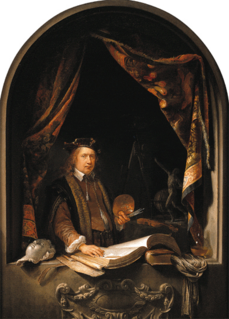
Gerrit Dou, also known as GerardDouw or Dow, was a Dutch Golden Age painter, whose small, highly polished paintings are typical of the Leiden fijnschilders. He specialised in genre scenes and is noted for his trompe-l'œil "niche" paintings and candlelit night-scenes with strong chiaroscuro. He was a student of Rembrandt.

The Laughing Cavalier (1624) is a portrait by the Dutch Golden Age painter Frans Hals in the Wallace Collection in London, which has been described as "one of the most brilliant of all Baroque portraits". The title is an invention of the Victorian public and press, dating from its exhibition in the opening display at the Bethnal Green Museum in 1872–1875, just after its arrival in England, after which it was regularly reproduced as a print, and became one of the best known old master paintings in Britain. The unknown subject is in fact not laughing, but can be said to have an enigmatic smile, much amplified by his upturned moustache.

Rembrandt Harmenszoon van Rijn, usually simply known as Rembrandt, was a Dutch Golden Age painter, printmaker and draughtsman. An innovative and prolific master in three media, he is generally considered one of the greatest visual artists in the history of art and the most important in Dutch art history.
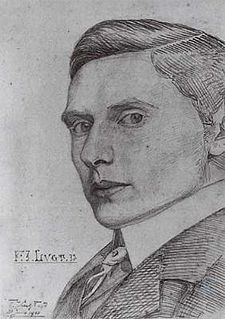
Frederik Johannes "Frits" Lugt, was a self-taught collector and connoisseur of Dutch drawings and prints and a selfless and tireless compiler of essential reference tools documenting Northern European prints and drawings, collectors' stamps and sale catalogues. An authority on Rembrandt's drawings, he collected all of the known etchings made by Rembrandt during his career.

The Fijnschilders, also called the Leiden Fijnschilders, were Dutch Golden Age painters who, from about 1630 to 1710, strove to create as natural a reproduction of reality as possible in their meticulously executed, often small-scale works.

Cornelis or Cornelius Ketel was a Dutch Mannerist painter, active in Elizabethan London from 1573 to 1581, and in Amsterdam till his death. Ketel, known essentially as a portrait-painter, was also a poet and orator, and from 1595 a sculptor as well.
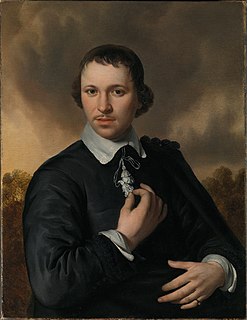
Jan van de Cappelle was a Dutch Golden Age painter of seascapes and winter landscapes, also notable as an industrialist and art collector. He is "now considered the outstanding marine painter of 17th century Holland".
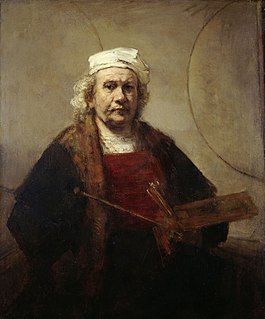
Self-Portrait with Two Circles is an oil on canvas painting by the Dutch artist Rembrandt, painted c. 1665–1669, one of over 40 painted self-portraits by Rembrandt.

View of Delft is an oil painting by Johannes Vermeer, painted ca. 1659–1661. The painting of the Dutch artist's hometown is among his best known, painted at a time when cityscapes were rare. It is one of three known paintings of Delft by Vermeer, along with The Little Street and the lost painting House Standing in Delft. The use of pointillism in the work suggests that it postdates The Little Street, and the absence of bells in the tower of the New Church dates it to 1660–1661. Vermeer's View of Delft has been held in the Dutch Royal Cabinet of Paintings at the Mauritshuis in The Hague since its establishment in 1822.
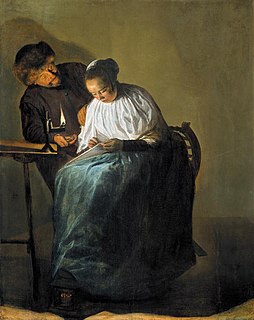
The Proposition is a genre painting of 1631 by Judith Leyster, now in the Mauritshuis in The Hague, who title it Man offering money to a young woman. It depicts a woman, sewing by candlelight, as a man leans over her, touching her right shoulder with his left hand. He is offering her coins in his right hand, but she is apparently ignoring the offer and concentrating intently upon her sewing. As we see the female protagonist ignore the advances of her suitor, this painting has been considered to potentially be a feminist work.
Sir Christopher John White CVO FBA is a British art historian and curator. He is the son of the artist and art administrator Gabriel White. He has specialized in the study of Rembrandt and Dutch Golden Age painting and printmaking.
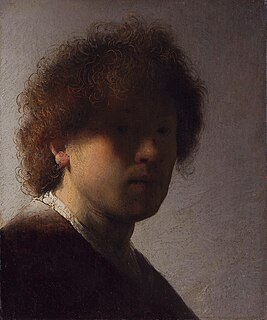
Self-Portrait with Dishevelled Hair, also known as Self-Portrait as a Young Man and by various other titles, is an early self-portrait by the Dutch artist Rembrandt. Now in the Rijksmuseum, it dates to 1628 and is an exercise in chiaroscuro. It is one of the earliest of over forty painted self-portraits by Rembrandt.

'Tronie' of a Young Man with Gorget and Beret, formerly known as Self-portrait as a young man is a tronie portrait of a young man that was traditionally regarded as one of over 40 painted self-portraits by Rembrandt. It is now in the Galleria degli Uffizi in Florence, where the most recent restoration by Daniele Rossi revealed a signature previously hidden under old varnish.

The Goldfinch is a painting by the Dutch Golden Age artist Carel Fabritius of a life-sized chained goldfinch. Signed and dated 1654, it is now in the collection of the Mauritshuis in The Hague, Netherlands. The work is a trompe-l'œil oil on panel measuring 33.5 by 22.8 centimetres that was once part of a larger structure, perhaps a window jamb or a protective cover. It is possible that the painting was in its creator's workshop in Delft at the time of the gunpowder explosion that killed him and destroyed much of the city.

Wilhelm Martin was a German-Dutch art historian.

The Oyster Eater or Girl Offering Oysters, is a c.1658-1660 small oil on panel painting by Jan Steen. Since 1936, it has been in the collection of the Mauritshuis in the Hague. This is a genre painting that demonstrates Steen's more intricate style and use of domestic settings. It also shows Steen's use of symbolism with oysters to create a theme of earthly lust.
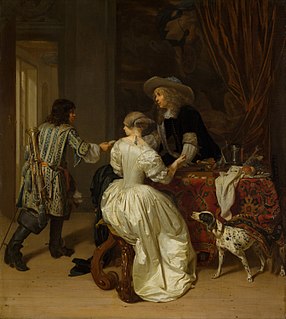
The Messenger is a 1674 oil painting by Johannes Verkolje which is in the collection of the Mauritshuis, in The Hague.

Portrait of Nicolaes Ruts (1573-1638) is a 1631 painting by the Dutch artist Rembrandt van Rijn. It is one of Rembrandt's earliest commissioned pieces and helped launch his career as a portrait painter. The painting is housed in the Frick Collection.
Eduard Siegfried"Eddy"de Jongh is a Dutch art historian specialized in iconography. He was professor of art history with a teaching assignment in iconography at Utrecht University between 1976 and 1989.


















